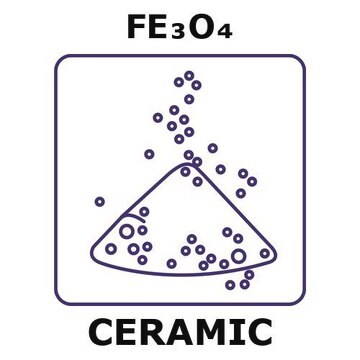544884
Iron(III) oxide
nanopowder, <50 nm particle size (BET)
Sinónimos:
Ferric oxide
About This Item
Productos recomendados
descripción
crystalline (primarily γ)
Nivel de calidad
Formulario
nanopowder
superficie
50-245 m2/g
tamaño de partícula
<50 nm (BET)
aplicaciones
battery manufacturing
cadena SMILES
O=[Fe]O[Fe]=O
InChI
1S/2Fe.3O
Clave InChI
JEIPFZHSYJVQDO-UHFFFAOYSA-N
¿Está buscando productos similares? Visita Guía de comparación de productos
Categorías relacionadas
Descripción general
Aplicación
Características y beneficios
- High theoretical specific capacity
- Biocompatibility
- Ease of coating and modification
- Non-toxicity
Código de clase de almacenamiento
13 - Non Combustible Solids
Clase de riesgo para el agua (WGK)
nwg
Punto de inflamabilidad (°F)
Not applicable
Punto de inflamabilidad (°C)
Not applicable
Equipo de protección personal
dust mask type N95 (US), Eyeshields, Gloves
Elija entre una de las versiones más recientes:
¿Ya tiene este producto?
Encuentre la documentación para los productos que ha comprado recientemente en la Biblioteca de documentos.
Los clientes también vieron
Artículos
Innovation in dental restorative materials is driven by the need for biocompatible and natural-appearing restoration alternatives. Conventional dental materials like amalgam and composite resins have inherent disadvantages.
Currently, magnetic nanoparticles (MNPs) are attracting a lot of attention because of the possibility of many novel applications, especially in biomedical research.
Graphene is a unique two-dimensional (2D) structure of monolayer carbon atoms packed into a dense honeycomb crystal that has attracted great interest due to its diverse and fascinating properties.
Global Trade Item Number
| Número de referencia del producto (SKU) | GTIN |
|---|---|
| 544884-25G | 4061838254061 |
| 544884-5G | 4061832567815 |
Nuestro equipo de científicos tiene experiencia en todas las áreas de investigación: Ciencias de la vida, Ciencia de los materiales, Síntesis química, Cromatografía, Analítica y muchas otras.
Póngase en contacto con el Servicio técnico






